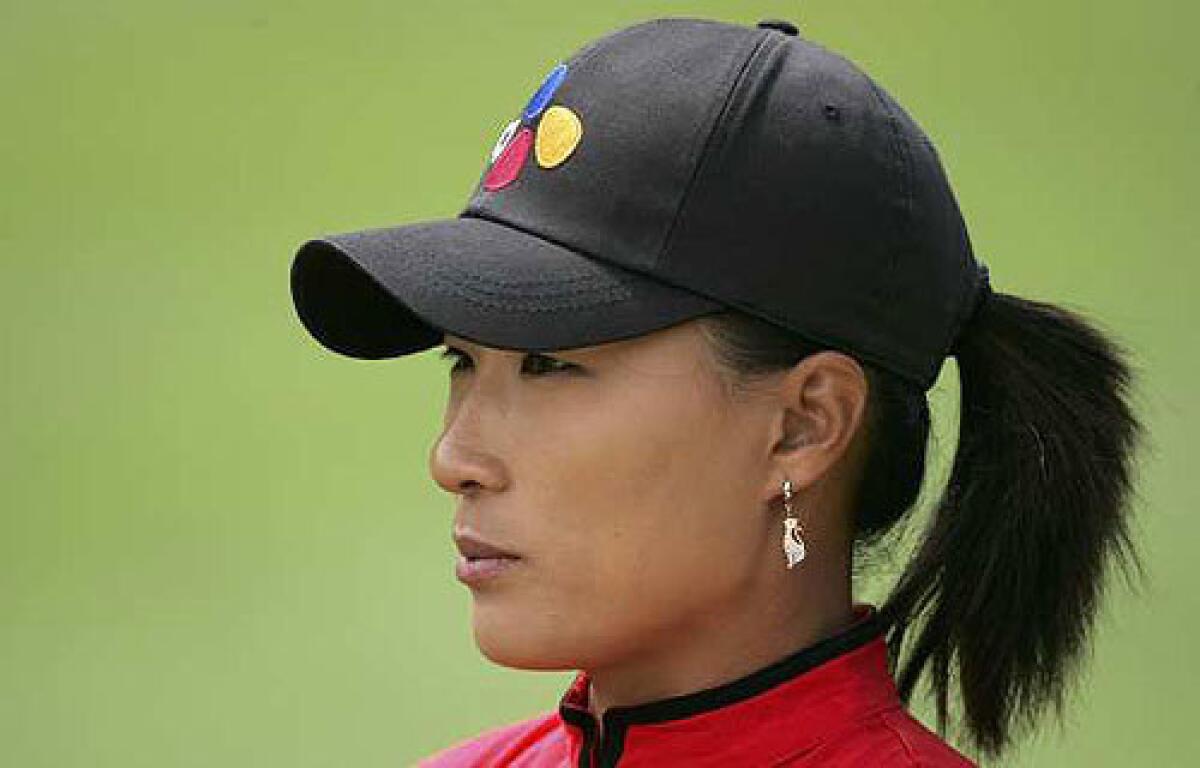Cultural Movement

As a child prodigy growing up in South Korea, Sihwan Kim figured that he would have to pack up his golf clubs and head for the United States.
In his home country he was relegated to hitting off mats at fenced-in driving ranges because the cost of golf in South Korea — about $200 a round — and the inaccessibility of courses, both public and private, make the sport difficult for middle-class citizens.
“It’s just not easy to play over there,” he said.
So, in 2000, Kim’s parents followed the lead of dozens before by moving to the United States to help advance their son’s budding golf career. The Kim family settled in Southern California, drawn by its large Korean population, warm weather and an abundance of golf courses and instructors. Kim was 11. Four years later, he was the U.S. Junior Amateur champion.
Kim will try to duplicate that championship this week at the U.S. Junior tournament, which began Monday at Rancho Santa Fe Golf Club in San Diego County. Chances are he’ll have to go through some fellow South Koreans to pull it off.
That’s because Koreans and Americans born to parents of Korean descent have become a major force on the U.S. junior golf circuit the last several years. It has also trickled to the college and professional ranks, especially on the LPGA Tour, where nine of the 18 winners this year have been Koreans.
And that doesn’t include Michelle Wie, 16, a Hawaii resident who has South Korean parents and is the world’s most famous Korean junior golfer even though she is now a pro.
Why is this happening?
There are myriad reasons, experts say: Good old-fashioned work ethic, a love for the game, a dedication to learning and a culture in Korea that places golf high in social status.
Another reason is the success of Se Ri Pak. When the 20-year old Korean qualified for the LPGA Tour in 1998, she won four times, including two major championships. That drew the attention of many Koreans. Pak has won more than 20 LPGA tournaments and $8 million in prize money and she has helped trigger a flood of Koreans to the driving ranges and the LPGA Tour.
“I wanted to be a professional figure skater,” said Jane Rah of Torrance, 16, the state high school girls’ golf champion, who is ranked No. 16 in the nation. “But when Se Ri Pak won the U.S. Open, it showed me that Koreans could play.”
Don Brown, the director of instruction at Harbor Golf Practice Center in Wilmington who teaches several rising Korean stars, expects more Korean players to emerge. “They’re serious,” he said. “They get on a schedule and stick to it. They’re different.”
Recent successes by Korean junior golfers have included Kim’s victory in the 2004 U.S. Junior and a U.S. Women’s Amateur Championship in 2004 by Jane Park, then 17. Park, who lives in Rancho Cucamonga, plans to turn pro next month.
The U.S. Girls’ Amateur championship, which began Monday in North Carolina, has had Korean champions in four of the last seven years and four of the last six second-place finishers are of Korean descent.
Among the top 50 boys in the current Golfweek magazine national rankings, 10 have Korean surnames. On the girls’ side, 18 players of Korean descent are in the top 50. And of the 77 tournaments conducted by the American Junior Golf Assn. so far this year, 14 — nearly 20% — have been won by Korean players.
That success has spilled to the adult amateur level. Three of the eight men’s quarterfinalists in the U.S. Amateur Public Links Championship last week were of Korean descent. At last month’s U.S. Women’s Amateur Public Links Championship, Tiffany Joh defeated Kimberly Kim in the final. Both are Americans born to South Korean parents.
And there is the stunning success of Koreans on the LPGA Tour, where eight Korean players have won this year. In 2005, there were also eight Korean winners. Before that, there had never been more than five.
“Oh, it’s totally getting tougher every year,” said Annika Sorenstam, the No. 1 women’s golfer in the world. “The last five years, you’ve seen a lot of players from all around the world and especially Korea. They have a lot of talent and they seem to do really well once they get to the top on the leaderboard and they seem to stay there.”
Bobby Lasken, a swing coach at Arroyo Trabuco Golf Club in Mission Viejo, has taught two Koreans that won the U.S. Junior championship: James Oh in 1998 and Sihwan Kim in 2004.
His success has drawn other Koreans to Lasken and half of his lesson book is now filled by Korean juniors. While many spend long hours with him honing their skills, they are not range rats, just beating balls all day, he said.
“They’re working differently than the other kids,” Lasken said. “They are really into perfecting the technical aspects. They are very savvy to how they should be swinging.”
KyeYoung Park, associate professor of anthropology and Asian-American studies at UCLA, said cultural factors help draw Koreans to golf.
Golf in Korea is very expensive and the game is limited to the upper classes. And even if players can afford the fees, there are only about 50 public courses in the country. So when young Koreans arrive in the U.S. and find green fees of under $30, they take up the game. “Golf in Korea is viewed as a lifestyle for the rich and famous,” KyeYoung Park said. “To be able to play golf is sort of a status symbol.”
Also, the Korean view of sports as a career began changing after the 1988 Olympics in Seoul, KyeYoung Park said. “Before the Olympics, Korean people never paid attention to sports as a career,” KyeYoung Park said. “If sports are now acceptable as a career and golf is a sport that gives you status, then of course you are going to play golf.”
Se Ri Pak, who began playing in 1990, was a product of that thinking. Like many of today’s young players, she was introduced to the game by her father.
Another factor in the success of Korean golfers is that many parents will uproot their family and move to the U.S. so their kids can pursue a golf career.
Frank Park, Jane’s father and golf coach, acknowledged that children sometimes practice hard out of respect to their families. “Juniors sometimes don’t have much of a choice. If the parents say you have to do it, then you do it,” he said.
Sihwan Kim’s father spends much of his time working in South Korea while his family lives in California. “You definitely realize what they are doing for you,” Sihwan Kim said. “It makes you want to work harder so that they aren’t disappointed.”
The flip side to this dedication is the risk of burnout. Se Ri Pak’s father reportedly forced her to practice for hours at a time.
After years of success, Pak in 2004 and in 2005 failed to crack the top 100 money list on the LPGA Tour for the first time. She took four months off from golf. “I was so much tired by the game,” Pak said. “It was such a hard time to focus.”
The break rejuvenated her. Last month she won the LPGA Championship, her first victory in two years.
Korean boys seem to fizzle more frequently than girls before advancing to the pro level, according to Frank Park, Jane Park’s father. K.J. Choi and Diamond Bar’s Kevin Na are the only Koreans on the PGA Tour.
“Americans have more balance when they are younger,” Frank Park said. “Korean players are dedicated only to golf. That’s why they are so good as juniors. But sometimes, they get sick of it.”
However, golf instructor Lasken insists he has seen as many American parents ruin budding careers as he has Koreans. “You see it everywhere where parents push, push, push,” he said.
But whatever the reason, the fact remains that young Koreans are a force in golf.
*
(INFOBOX BELOW)
In the money
Koreans in LPGA leaders (Michelle Wie, who has won $444,951, isn’t LPGA member).
1. Lorena Ochoa...$1,446,641
2. Annika Sorenstam...$1,290,382
3. Karrie Webb...$1,197,433
4. Mi Hyun Kim...$1,014,724
5. Juli Inkster...$975,571
6. Hee-Won Han...$771,533
7. Brittany Lincicome...$764,806
8. Seon Hwa Lee...$742,927
9. Pat Hurst...$719,154
10. Jeong Jang...$677,771
11. Cristie Kerr...$653,030
12. Paula Creamer...$647,869
13. Se Ri Pak...$621,439
14. Natalie Gulbis...$573,441
15. Meena Lee...$420,905
16. Julieta Granada...$380,286
17. Stacy Prammanasudh...$354,308
18. Sung Ah Yim...$349,941
19. Shi Hyun Ahn...$347,758
20. Ai Miyazato...$336,684
More to Read
Go beyond the scoreboard
Get the latest on L.A.'s teams in the daily Sports Report newsletter.
You may occasionally receive promotional content from the Los Angeles Times.










